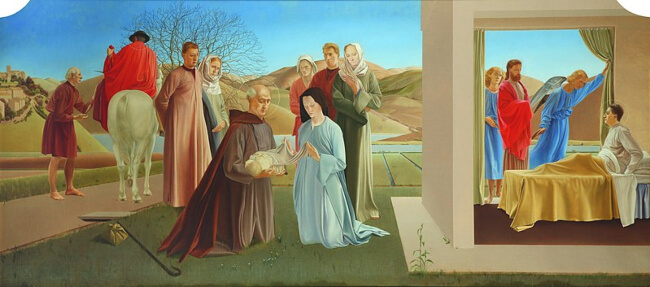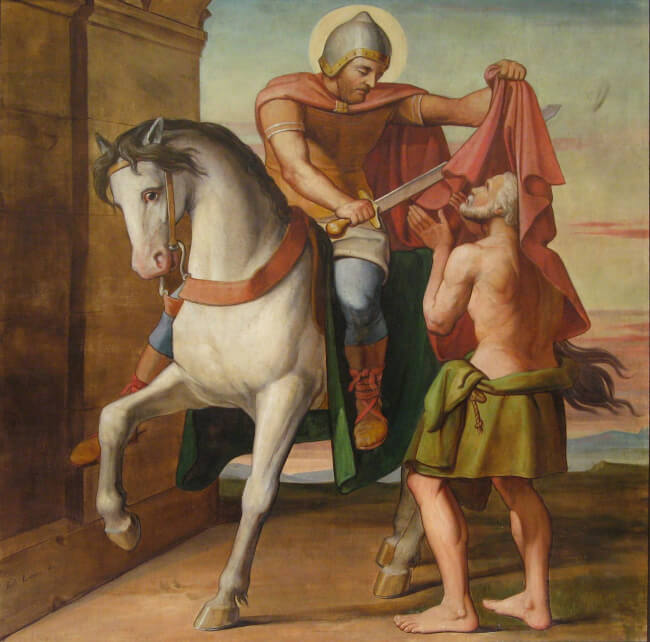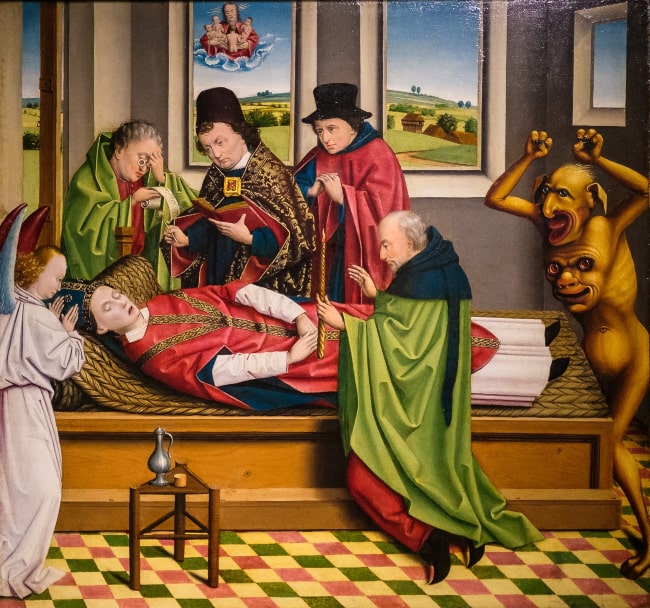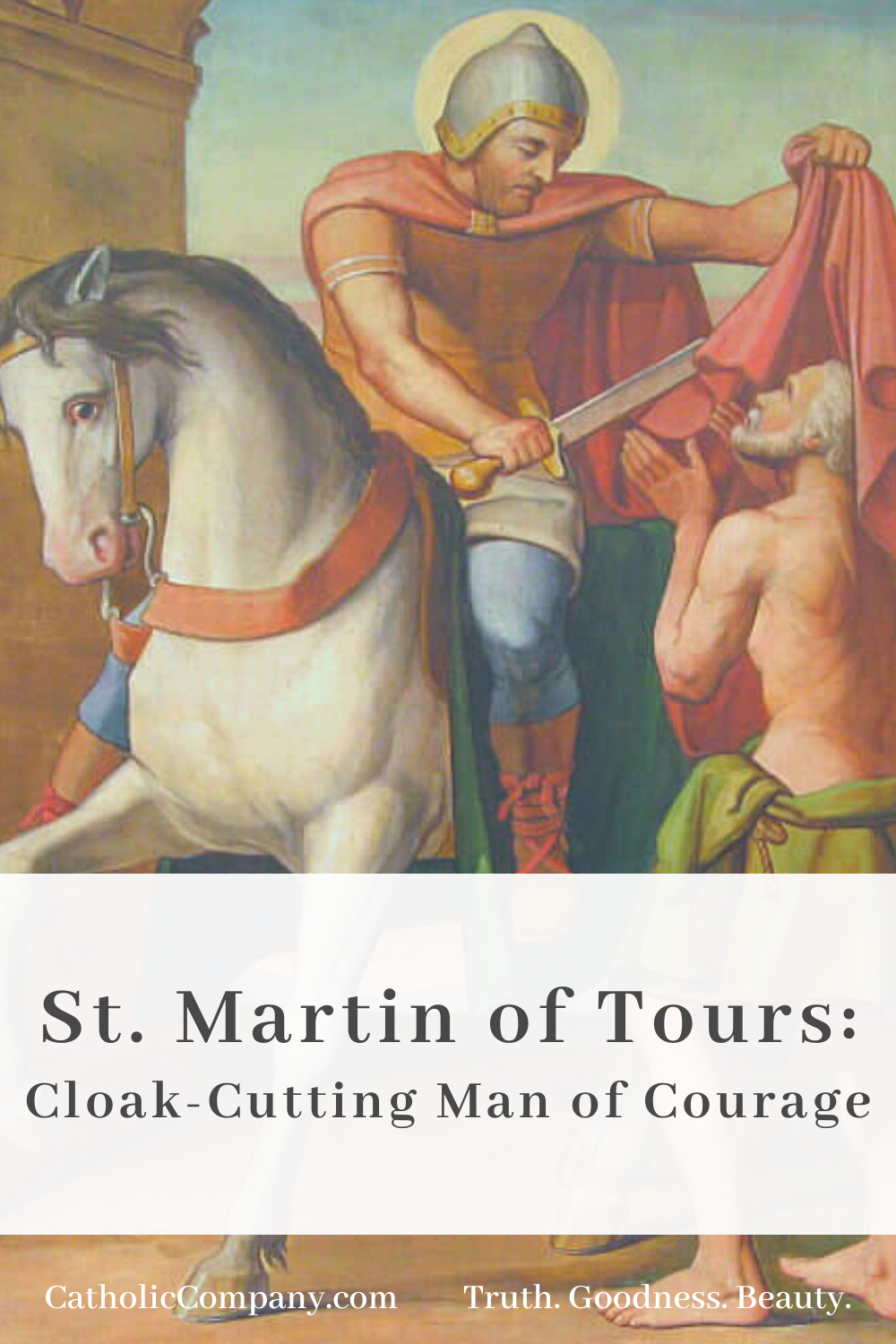St. Martin of Tours: Cloak-Cutting Man of Courage
Nov 11, 2020 by Michael Lynch
In addition to being Armistice Day and Veterans Day, November 11th is the Feast of St. Martin of Tours, patron saint of France, soldiers, and beggars.
The most famous incident in Martin's life occurred during his time as a Roman soldier, when he encountered a poor man in rags begging at the gate of a city. He cut his military cloak in two and gave half to the man. The next night Jesus, wearing the gifted cloak, appeared to Martin in a dream and announced to the angels, "Martin, who is still but a catechumen, clothed me with this robe."
![]()
After leaving military service, his reputation for holiness led to a popular movement to make him Bishop of Tours, a city in what is now France.
St. Martin would be widely venerated by the French throughout the Middle Ages, with a revival of devotion to him starting in the 19th century.
The Life and Context of St. Martin of Tours
St. Martin was born in 316 in the Roman Empire, in what is now central Europe. Shortly after the Edict of Milan and the Roman toleration of Christianity, he lived to see the establishment of Christianity as the Roman state religion in 380, and died in 397.

Clearly, this was a period of growth for Christianity's influence and prestige. It was also, however, a time of widespread paganism. Martin’s own parents were pagans. He himself adopted Christianity on his own at around age ten.
Within the Church the Arian heresy, denying the full divinity of Jesus, was widespread among bishops and clergy. Bishops who defended Christ’s divinity—such as St. Athanasius of Alexandria and Martin’s mentor St. Hilary of Poitiers—faced persecution and exile during their episcopacies.
[[19197, 196]]
St. Martin's Virtue
In this context of significant change in Christianity’s role in the secular order, along with historic division and confusion within the Church itself, St. Martin is one of the enduring examples of Christian virtue. What characteristics marked this exceptional man?
One of the main sources of information that we have is the Life of St. Martin by Sulpicius Severus, a contemporary personally known to the saint. The incidents he recounts reveal some of the chief traits of Martin:
Courage rooted in faith in Christ:
-
While still in the army, Martin determined that
he should no longer fight after his baptism.
Facing accusations of cowardice, he volunteered to be on the front line
of an impending battle without any weapons but divine protection. The opposing side surrendered unexpectedly
before the battle.
- After leaving the army, Martin was captured by violent robbers on a mountain road. One of his captors asked if Martin were afraid. Martin replied that he in fact felt safer than ever, because he was confident that God would be present with him. He added that he feared rather for the robber than for himself, since the robber was leading a sinful life. The robber converted to Christianity after his time with Martin.
Constant charity and sacrifice:
- During his military service, while yet an
unbaptized catechumen, Martin had a reputation for caring for the poor while having
little regard for his own material circumstances.
- On the famous occasion when he split his cloak with a beggar, he had no other clothing to give because he had already given away so much to others before.

Pursuit of seclusion and dedication to prayer:
- As a catechumen at age twelve, he desired to become a hermit. Obligated to military service, this had to be postponed.
- After his military service, he lived in several places as a monk or a hermit, with exiles and persecutions driving him from location to location.
- When he became the Bishop of Tours, his new station did not permit quite the same lifestyle as previously. However, finding that a cell in a church in the city did not permit enough solitude, he took to living in a mountain cave a few miles outside of the city. An austere community of monks formed around him.

What We Can Learn From St. Martin's Example
Armed with these holy acts and virtues, St. Martin became a great evangelist to pagans and a stalwart opponent of the Arian clergy in his region. He experienced joy in this, converting even his own mother to Christianity—yet he also suffered scourging and exile at the hands of heretical clergy.
Christian living, at a basic level, is the conformation of one’s own life to the life of Christ. The saints are among those who have done this in exemplary ways within the circumstances of their own lives. For those of us removed from the life of St. Martin in time, place, and station of life, we can compare his times to our own and take inspiration from his handling of challenges that, in some cases, may be similar to our own.
We can each discern what in Martin’s circumstances is relevant to our own situation in life. We can adapt Martin’s great example to our own circumstances, just as he himself lived his Christian life to an exemplary degree in his various states as soldier, layman, minor cleric, and bishop.
Sancte Martine, ora pro nobis!






